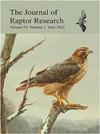狼獾(Gulo Gulo)在挪威被记录为大灰猫头鹰(Strix nebulosa)的捕食者
IF 1.2
4区 生物学
Q2 ORNITHOLOGY
引用次数: 0
摘要
大灰猫头鹰(Strix nebulosa)在古北和新北极地区的北方森林地带(分别为s.n. lapponica和s.n. nebulosi亚种)均有环极分布。在过去的四十年中,古北亚种向斯堪的纳维亚半岛的南部和西南部扩展了其活动范围(Sonerud et al. 2021和其中的参考文献)。这种扩张包括北欧的大部分地区(Ławicki et al. 2013)。自2009年以来,挪威海德马克县至少记录了445次筑巢尝试(Berg et al. 2011, Berg 2016, Berg et al. 2019)。狼獾(Gulo Gulo)是鼬科动物中最大的成员,体重可达18公斤(Wilson and Mittermeier 2009)。它栖息在欧亚大陆和北美的针叶林中(Wilson and Mittermeier 2009)。狼獾能够杀死大型有蹄类动物,如驯鹿(Rangifer tarandus),但它通常是一种机会主义的捕食者,经常以尸体为食(Wilson和Mittermeier 2009)。自2010年灰鸮扩张开始以来,狼獾就在海德马克县的北半部繁殖(Flagstad et al. 2013, Tovmo and Mattisson 2021)。已知最南端的狼狼巢穴与2021年调查的四个灰鸮平台位于同一区域(图1)。巢穴捕食是许多鸟类死亡的常见原因(Caro 2005和其中的参考文献)。鼬鼠捕食哺乳动物和鸟类(Wilson and Mittermeier 2009),欧洲松貂(Martes Martes)尤其栖息在树上,是已知的洞穴筑巢猫头鹰和鸭子的捕食者(Korpimäki and Hakkarainen 2012, Sonerud 1985, 2021a, 2021b)。一些大灰猫头鹰已经尝试在海德马克县的地面巢穴筑巢,并且都已经被发现(Berg et al. 2011)。自2011年以来,当地鸟类学家在海德马克县建立了越来越多的人工筑巢平台(见Stefansson 1997, Solheim 2014),到2022年安装了0.400个平台,2018年有48%的筑巢尝试发生在平台上(Berg et al. 2019)。在这里,我们报告了狼獾作为灰鸮巢穴捕食者在巢穴平台上筑巢的第一个记录。2021年5月和6月,在挪威东南部海德马克县中部(60851N, 11859E),用野生动物摄像机监测了人工平台上的四个灰鸮巢穴(图1)。被监测的平台位于海德马克县中部的Kynna水道沿岸,距离最远的两个平台,1号平台和4号平台之间有31.6公里。平台放置在离地面约5.5米的松树(Pinus sylvestris)或云杉(Picea abies)树上。其中三个平台(2号平台,3号平台和4号平台)是前几年筑巢的灰鸮使用的。架设了七台野生动物摄像机来监控平台。摄像机类型包括Boscon Guard Entry (n1⁄4 3),Spypoint Force Dark (n1⁄4 2),Moultrie No-glow (n1⁄4 1)和Glory LTE, L4-E (n1⁄4 1)。摄像机安装在距离平台2 - 5米的树干上。相机设置为触发时拍摄三张图像,并在拍摄下一张图像之前暂停1分钟。2021年5月31日,1、3和4站台更换了电池和存储卡。相机是在雏鸟羽翼丰满或消失后收集的。7个摄像头中的3个在另一个摄像头捕捉到平台上的运动时没有触发,或者电池故障。在所有四个平台上,至少有一个摄像头正常工作并定期拍摄图像。共记录图像153600张:1号站台7026张;2号站台22,800张图像;3号平台74,531张图像;4号站台49243人。1邮件地址:r-solhe3@online.no本文章由计算机程序翻译,如有差异,请以英文原文为准。
Wolverine (Gulo gulo) Recorded as Predator of Nestling Great Gray Owls (Strix nebulosa) in Norway
The Great Gray Owl (Strix nebulosa) has a circumpolar distribution in the boreal forest zone (Cramp 1985) in both the Palearctic and Nearctic region (subspecies S. n. lapponica and S. n. nebulosi, respectively). The Palearctic subspecies has extended its range toward the south and southwest in Scandinavia during the last four decades (Sonerud et al. 2021 and references therein). This expansion includes most of northern Europe (Ławicki et al. 2013). Since 2009, at least 445 nesting attempts were recorded in Hedmark County, Norway (Berg et al. 2011, Berg 2016, Berg et al. 2019). The wolverine (Gulo gulo) is the largest member of the mustelid family, weighing up to 18 kg (Wilson and Mittermeier 2009). It inhabits the taiga in both Eurasia and North America (Wilson and Mittermeier 2009). The wolverine is capable of killing large ungulates such as reindeer (Rangifer tarandus), but it is generally an opportunistic feeder that regularly scavenges on carcasses (Wilson and Mittermeier 2009). Wolverines have bred in the northern half of Hedmark County since 2010, when the Great Gray Owl expansion started (Flagstad et al. 2013, Tovmo and Mattisson 2021). The southernmost known wolverine dens are in the same area as four Great Gray Owl platforms surveyed in 2021 (Fig. 1). Nest predation is a common cause of mortality for many bird species (Caro 2005 and references therein). Mustelids prey on both mammals and birds (Wilson and Mittermeier 2009), and European pine martens (Martes martes) are especially arboreal and known predators of cavity-nesting owls and ducks (Korpimäki and Hakkarainen 2012, Sonerud 1985, 2021a, 2021b). A few Great Gray Owls have made nesting attempts at ground nests in Hedmark County and all have been predated (Berg et al. 2011). Since 2011, an increasing number of artificial nest platforms (see Stefansson 1997, Solheim 2014) have been erected by local ornithologists in Hedmark County, resulting in .400 platforms installed by 2022 and 48% of nesting attempts occurring on platforms in 2018 (Berg et al. 2019). Here we report the first record of wolverine as a nest predator of Great Gray Owl nestlings on nest platforms. Four Great Gray Owl nests on artificial platforms were monitored with wildlife cameras in central Hedmark County in southeastern Norway (60851N, 11859E) in May and June 2021 (Fig. 1). The platforms surveilled were located along the Kynna watercourse in central Hedmark County, with 31.6 km between the two most-distant platforms, platform 1 and platform 4. Platforms were placed approximately 5.5 m above ground in pine (Pinus sylvestris) or spruce (Picea abies) trees. Three of the platforms (platforms 2, 3, and 4) were used by nesting Great Gray Owls in previous years. Seven wildlife cameras were erected to monitor the platforms. Camera types included Boscon Guard Entry (n1⁄4 3), Spypoint Force Dark (n1⁄4 2), Moultrie No-glow (n1⁄4 1), and Glory LTE, L4-E (n1⁄4 1). The cameras were mounted on tree trunks 2–5 m from the platforms. Cameras were set to take three images when triggered, and to pause for 1 min prior to taking the next image. Batteries and memory cards were changed at platforms 1, 3, and 4 on 31 May 2021. The cameras were collected after the nestlings had fledged, or otherwise disappeared. Three of the seven cameras either failed to trigger when the other camera captured movement at the platforms, or the batteries failed. At all four platforms, at least one camera functioned and captured images regularly. A total of 153,600 images were recorded: 7026 images at platform 1; 22,800 images at platform 2; 74,531 images at platform 3; and 49,243 at platform 4. 1 Email address: r-solhe3@online.no
求助全文
通过发布文献求助,成功后即可免费获取论文全文。
去求助
来源期刊

Journal of Raptor Research
生物-鸟类学
CiteScore
2.30
自引率
17.60%
发文量
61
审稿时长
>12 weeks
期刊介绍:
The Journal of Raptor Research (JRR) is an international scientific journal dedicated entirely to the dissemination of information about birds of prey. Established in 1967, JRR has published peer-reviewed research on raptor ecology, behavior, life history, conservation, and techniques. JRR is available quarterly to members in electronic and paper format.
 求助内容:
求助内容: 应助结果提醒方式:
应助结果提醒方式:


